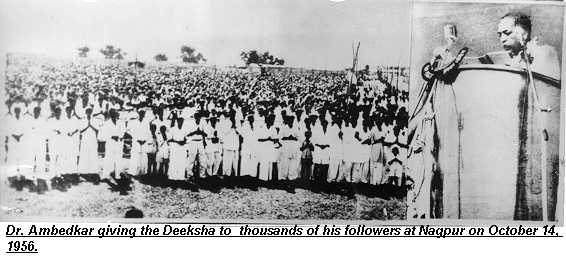Buddhism: The Significance of 14th Oct, 1956
– BR Bhardwaj
THE ASIAN INDEPENDENT, UK
Surendra Ajnat (1983) in his book “बुद्धधम्मः भ्रान्ति निवारणं” beautifully described Buddha`s teachings “The great man Buddha has said: Kalamo, do not go after what has been ingrained in your mind due to repeated hearing, nor the things coming from forefathers, nor rumours. Do not go after what is written in religious scriptures, nor do you go after doubtful and suspicious things. Do not go after things that are said to be self-evident, nor do you go after empty arguments. Do not go with a pred-determined bias towards any idea or principle nor be biased towards any idea or principle because this idea has been before, that is, we are already familiar with it. Do not go after someone`s superficial qualifications nor with the thought that ‘this sanyasi /bhikshu/person is our Guru, hence, everything he says will be true. ‘Kalamo, when you come to know the Buddha, when your own intelligence, your own conscience tells you that a certain thing is innocent, a certain thing is praised by the wise, adopting and practising a certain thing will bring benefit and happiness -then accept it and follow it firmly[1].
The Dalits of the world are grateful to Bharat Ratna Baba Saheb Dr. Bhimrao Ramji Ambedkar (14th April 1891-6th Dec,1956) who embraced Buddhism at Nagpur (Maharashtra) with millions of Dalits and urged them to embrace Buddhism. The choice of Buddhism was not in hurry but Dr. Ambedkar read all religions and faiths of the world before embracing Buddhism. In 1950, he not only praised the Buddha at the expense of Krishna, Christ, and Mohammed but also visited Ceylon at the invitation of the Young Men’s Buddhist Association, Colombo, addressed a meeting of the World Fellowship of Buddhists in Kandy, and appealed to the Untouchables of Ceylon to embrace Buddhism. In 1951 Dr Ambedkar defended the Buddha against the charge that he had been responsible for the downfall of the Indian woman and compiled the Buddha Upasana Patha, a small collection of Buddhist devotional texts.
In 1955 he founded the Bhartiya Bauddha Mahasabha or Indian Buddhist Society and installed an image of the Buddha in a temple that has been built at Dehu Road, near Poona. On the evening of 5 December, he asked the Preface and Introduction to The Buddha and His Dhamma to be brought to his bedside, so that he could work on them during the night, and the following morning, he was found dead. It was 6 December, he was 64 years and 7 months old, and he had been a Buddhist for only seven weeks.
The book was written during the years 1951-156 and published by the People’s Education Society in November,1957 almost a year after the great leader`s death. The writing of the Buddha and His Dhamma was thus an attempt on Ambedkar`s part to produce the Buddhist Bible which he had, in his 1951 article, pronounced ‘quite necessary’ if the ideal of spreading Buddhism was to be realised. Despite his use of the inappropriate term’ Bible’. however, Ambedkar was far from regarding the Buddha and His Dhamma as possessing any special authority. As he wrote of the work in the (recently published preface, ‘How good it is I must leave it to readers to judge. As for myself, I claim no originality. I am only a compiler. All I hope is that readers will like the presentation. I have made it simple and clear[1].
Ambedkar`s approach to Buddhism thus is social and ethical rather than philosophical and mystical. The schools (Mahayana & Hinayana) of Buddhism are unanimous that Dharma-dana, the Gift of the Doctrine, is the highest form of Giving. It is this fact which makes Buddhism a missionary religion in the true sense of the term. According to Buddha, ‘All Happiness ends in sorrow, and life ends in death. All creatures begin their journey towards death from the very moment of their conception in the womb. Powerful monarchs, skilled archers, clever magicians, haughty deva, furious elephants, ferocious lions and tigers, venomous serpents and malignant demons-all these can quell, subdue and slay their enemies, but even they are powerless against death, the fierce and irresistible foe of all living beings. Realizing the peril of death, a wise man should feel fear and trepidation(samvega) and resolve to become a Bodhisattva’[2]. There is NO soul concept in Buddhism.
It is a fact that there is substantial increase in the Buddhist population. According to the 2011 census, the Buddhist population in India is 0.84 crores. In every part of India there is a mass religious conversion and people are found embracing Buddhism and quitting Manuwad which is responsible for the prevalence of the caste system in India. Buddha Vihara are being set up in almost every part of the world. Revival of Buddhism in India is on the move. Nevertheless, it becomes a duty of each Ambedkarite to propagate Buddhism with enthusiasm and vigour. Dr. Ambedkar made 22 Buddhist vows and urged the followers to do the same. We all must follow.

v Shri Baldev Raj Bhardwaj is a retired Senior Manager from Bank of India. He is associated with Ambedkar Mission for the last more than 40 years. He is a staunch Ambedkarite & practising Buddhist. He is a trustee of Ambedkar Bhawan Trust (Regd), Jalandhar. He contributes article to national & international newspapers. He is also a social activist and has been aggressively raising the issues of the downtrodden at the national level.
[1] Surendra Ajnat(1983), बुद्धधम्मः भ्रान्ति निवारणं , Buddhist Publishing House, Pvt Ltd, Jalandhar,p.8&9.








